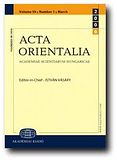Acta Orientalia 2011 - Vol. 64
Acta orientalia Academiae Scientiarum Hungaricae
Acta orientalia Academiae Scientiarum Hungaricae = A Magyar Tudományos Akadémia Orientalisztikai közleményei / Magyar Tudományos Akadémia <Budapest>. - 64 (2011). - Budapest : Akadémiai Kiadó, 2011
ISSN 0001-6446 (Print)
ISSN 1588-2667 (Online)
URL: Akadémiai Kiadó
URL: Online-Ausgabe
DOI: 10.1556/AOrient.64.2011.1.1
Abstract: The paper shows on the example of Vājīd, a poet once popular but neglected in colonial and nationalist historiography, that rich treasures of Indian literature still await unearthing and philological work. The extraordinary popularity of Vājīd (fl. 1600) in Hindi before the advent of western modernism is shown by the high number of manuscripts containing his works and by the fact that he was considered to be the best exponent of the poetic form arilla. Hardly anything of his more than hundred and twenty works is published today and he is scarcely mentioned in modern literary histories. The paper examines early sectarian and secular sources on Vājīd’s life, compares them with Vājīd’s poetry and with early manuscript material, follows up his modern reception and presents the range of this poet’s works.
DOI: 10.1556/AOrient.64.2011.2.6
Abstract: New identifications of seven statuettes from Surocolo are proposed on the basis of the Nayasūtramaḍḍala from the Shingon denomination of Japanese Mantrayāna, whose central Buddha is Vajrasattva.
DOI: 10.1556/AOrient.64.2011.3.5
Abstract: In the Mongol period, the Uighurs who settled around the Turfan region not only translated Chinese Buddhist works into the Uighur language, but also directly copied them in Chinese characters or composed original works with the combination of arbitrary quotations from Chinese works. The Insadi-Sūtra is such a work in question. The author of this paper succeeded in identifying two Chinese Buddhist texts written by Uighurs. They will help us better understand the background in which these Uighur-Chinese mixed texts came about.
DOI: 10.1556/AOrient.64.2011.4.2
Abstract: This paper presents an edition of a newly identified Old Uyghur fragment of the Lotus Sūtra from the Krotkov collection in the Institute of Oriental Manuscripts of the Russian Academy of Sciences. The text mainly explains the merit of preaching, reciting and hearing the Lotus Sūtra through three parables, claiming that the text is from the nom čäčäki sudur ‘Law-Flower-Sūtra’, the Old Uyghur title of the Lotus Sūtra. However, there is no identical passage in the known Chinese translations of the Lotus Sūtra. Presumably, the Old Uyghur text is a unique composition by Uyghurs, though one cannot exclude the possibility that the Old Uyghur text might also be a translation of an unknown Chinese text of similar content.
DOI: 10.1556/AOrient.64.2011.4.3
Abstract: The Hayagrīvavidyā included in a Gilgit manuscript belongs to the earliest works invoking the god Hayagrīva. It is a spell which could be applied to achieve several aims. The god destroys the enemies, rescues from danger, his mantra protects against all sorts of evil, demons and black magic. His mare-face is believed to counteract the effects of enemy mantras.
Ähnlich
- Journal Asiatique 2011 - Vol. 299,2
- Journal Asiatique 2011 - Vol. 299,1
- Journal Asiatique 2010 - Vol. 298,2
- JAS 2011 - Vol. 70,1
- Journal Asiatique 2010 - Vol. 298,1
- Tohogaku 2010 - 119
- Journal of the Royal Asiatic Society 2010 - 20,1
- Scripta 2009 - 1
- Rivista degli Studi Orientali 2007 - Vol. 80
- Asiatische Studien 63,1 (2009)

